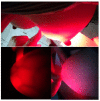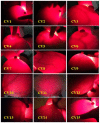Fabrication of a Reflective Optical Imaging Device for Early Detection of Breast Cancer
- PMID: 38002396
- PMCID: PMC10669754
- DOI: 10.3390/bioengineering10111272
Fabrication of a Reflective Optical Imaging Device for Early Detection of Breast Cancer
Abstract
This work presented the design and fabrication of a blood vessel and breast tumor detection device (BKA-06) based on optical energy spectroscopy. The BKA-06 device uses red-to-near-infrared light-emitting diodes that allow physicians or physicians to visualize blood vessels and surface structures such as breast tumors with the naked eye. The device consists of a built-in current control circuit to have the appropriate brightness (maximum illuminance of 98,592 lux) for the examination of superficial tumors deep under the skin, with a scan time of 3-5 min. The device BKA-06 can facilely observe each layer of blood vessels at the depth of the skin. For breast tumors, the location, size, and invasive areas around the tumor can also be visualized with the naked eye using the BKA-06 sensor. The results show that the BKA-06 sensor can provide clear breast tumor and vascular images, with a penetration of up to 15 cm in the skin and tissue layers of the breast. The breast tumor scanning tests with the BKA-06 sensor gave patients quick results and compared them through cell biopsy and MRI, respectively. The device has the advantages of being simple and easy to use, providing potential practical applications in the medical field and reducing costs for patients when taking MRI or CT scans. Therefore, the BKA-06 device is expected to help doctors and medical staff overcome difficulties in infusion, as well as identify breast tumors to support early breast cancer diagnosis and treatment.
Keywords: BKA-06; blood vessels detection device; medicine; red LED lights.
Conflict of interest statement
The authors declare no conflict of interest.
Figures












Similar articles
-
[Laparoscopic and general surgery guided by open interventional magnetic resonance].Minerva Chir. 2004 Oct;59(5):507-16. Minerva Chir. 2004. PMID: 15494679 Italian.
-
Role of In Vivo Reflectance Confocal Microscopy in the Analysis of Melanocytic Lesions.Acta Dermatovenerol Croat. 2018 Apr;26(1):64-67. Acta Dermatovenerol Croat. 2018. PMID: 29782304 Review.
-
Is Reoperation Higher Than Expected after Below-the-knee Amputation? A Single-center Evaluation of Factors Associated with Reoperation at 1 Year.Clin Orthop Relat Res. 2021 Feb 1;479(2):324-331. doi: 10.1097/CORR.0000000000001455. Clin Orthop Relat Res. 2021. PMID: 32833926 Free PMC article.
-
More advantages in detecting bone and soft tissue metastases from prostate cancer using 18F-PSMA PET/CT.Hell J Nucl Med. 2019 Jan-Apr;22(1):6-9. doi: 10.1967/s002449910952. Epub 2019 Mar 7. Hell J Nucl Med. 2019. PMID: 30843003
-
Development and clinical translation of photoacoustic mammography.Biomed Eng Lett. 2018 May 7;8(2):157-165. doi: 10.1007/s13534-018-0070-7. eCollection 2018 May. Biomed Eng Lett. 2018. PMID: 30603200 Free PMC article. Review.
Cited by
-
Advances in breast cancer diagnosis: a comprehensive review of imaging, biosensors, and emerging wearable technologies.Front Oncol. 2025 Jun 18;15:1587517. doi: 10.3389/fonc.2025.1587517. eCollection 2025. Front Oncol. 2025. PMID: 40606998 Free PMC article. Review.
References
-
- Duong Thi Tuan A. Assessment of the Actual Situation of Performing Intravenous Injection Procedures by Nurses in Construction Hospitals. KHKT Publisher; Hanoi, Vietnam: 2011.
-
- Dang Thi Thanh T. Knowledge, Skills to Practice Safe Injection and Some Related Factors of Students at Kon Tum Medical Secondary School in 2016. KHKT Publisher; Hanoi, Vietnam: 2016. pp. 12–14.
Grants and funding
LinkOut - more resources
Full Text Sources

